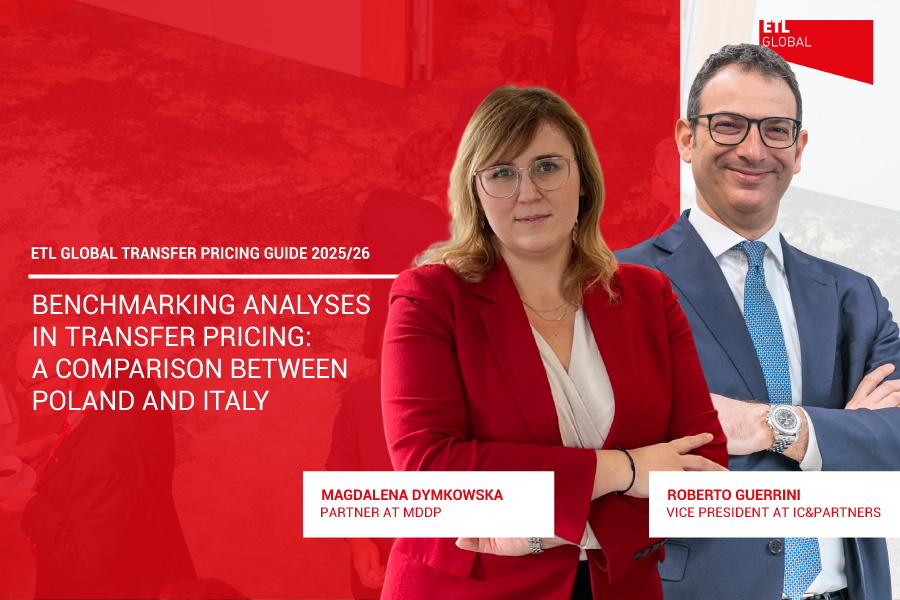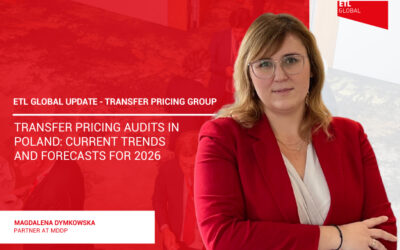Benchmarking analyses are an essential part of transfer pricing documentation, providing a reliable basis for ensuring that intercompany transactions comply with the arm’s-length principle. For companies operating across borders, understanding how benchmarking works in different jurisdictions is crucial. In this post, In this post, Magdalena Dymkowska, from MDDP and Roberto Guerrini, from IC&Partners, compare how benchmarking is approached in Poland and Italy, touching on aspects such as the frequency of updates, data sources, the preferred point in the range, and the most commonly used verification methods.
Introduction to Benchmarking in Transfer Pricing
Benchmarking analyses allow companies to assess whether their intercompany transactions are conducted at arm’s length by comparing them with similar third-party transactions. The general approach to performing such analyses is largely based on the OECD Transfer Pricing Guidelines. However, the interpretation of results as well as the formal requirements for benchmarking may vary across jurisdictions, such as Poland and Italy. Moreover, the Guidelines serve as an important reference tool but are not formally incorporated into domestic law. As a result, although the methodology is broadly consistent across jurisdictions, expectations and preferences of tax authorities can vary.
Frequency of Benchmarking Updates
Polish regulations specify that benchmarking studies should not be updated less frequently than every three years unless there is a significant change in economic conditions that justifies an even earlier update. It’s important to note that simply updating the financial data of entities in the final sample does not constitute a complete update of the benchmarking analysis. A thorough review of the entire analysis is required, i.e. new data export from the database, automatic and manual selection and financial analysis.
The benchmarking analysis is also an obligatory element of the Local File in Poland. Where benchmarking is not possible, a compliance analysis should be prepared.
In Italy, benchmarking analyses must be updated annually, since transfer pricing documentation is prepared for each tax period as a necessary condition to benefit from the non-application of penalties in the event of an adjustment by the tax authority. For small and medium-sized enterprises (with revenues or turnover not exceeding 50 million euros), a simplification applies: the data used for comparability purposes may be updated every three years, unless a significant change in economic conditions occurs that justifies an earlier update. However, the financial data of the company under analysis must still be updated annually.
Benchmarking analysis is also a mandatory element of the Local File in Italy. Where benchmarking is not feasible, the taxpayer is nevertheless required to demonstrate compliance with the arm’s length principle.
Data Sources Accepted
In Poland, both local comparables and pan-European / global data are accepted for benchmarking studies. However, there is a slight preference for local comparables, meaning that taxpayers should include local market data in their search strategy where possible. Global or pan-European databases are also acceptable when they are the most appropriate for the transaction in question.
Moreover, for the benchmarking analysis, Poland accepts internal and external comparables, and adjustments may be made to align foreign data with Polish market conditions.
Italian legislation does not require the exclusive use of local databases, allowing the use of pan-European or global databases when domestic comparables are not available or sufficient, or when they are deemed more appropriate for the transaction under review. Both internal and external comparables are accepted.
Italian tax authorities generally show a preference for domestic comparables, as they are considered more representative of market conditions. Where foreign data are used due to the lack of local data or because they are considered more appropriate for the transaction under analysis, it may be necessary to apply comparability adjustments to reflect the differences between markets.
Preferred Market Range
Poland follows the OECD guidelines, which state that any point within the interquartile range (IQR) of comparables is considered arm’s length. This means that the IQR is preferred, and the median is not mandatory.
Italian legislation has introduced the notion of the arm’s length range, in line with OECD Guidelines, specifying that:
- If the analysis performed is reliable and the identified transactions all have the same level of comparability, the entire range of values resulting from the application of the financial indicator selected using the most appropriate method (so-called “full range”) must be taken into consideration, each value being considered compliant with the arm’s length principle.
- If the transactions within the range of values do not have the same level of comparability with the controlled operation, it’s necessary to refer to “statistical tools” to narrow the range and strengthen its reliability, provided that there is a significant number of operations. In this case the interquartile range constitutes the reference range.
If the taxpayer’s result falls outside the reference range, an adjustment is required. To avoid the adjustment, the taxpayer must demonstrate that the indicator used complies with the arm’s length principle. The tax authority considers the median as the preferred reference point in the event of adjustments, unless the taxpayer demonstrates that another point within the reference range better reflects the arm’s length conditions in the specific case.
Commonly Used TP Methods
Poland accepts all five of the OECD-approved transfer pricing methods:
- Comparable Uncontrolled Price (CUP) Method,
- Cost Plus Method,
- Transactional Net Margin Method (TNMM),
- Resale Price Method,
- Profit Split Method.
In practice, TNMM is the most commonly used method, especially for transactions like distribution and services. The CUP method is often used for financial transactions and intellectual property transfers when market data is available. The selection of the appropriate method depends on the nature of the transaction and the availability of comparables.
Italian legislation also recognizes all five OECD methods, namely the traditional transaction methods (CUP, Resale Price, and Cost Plus) and the transactional profit methods (TNMM and Profit Split).
In applying the “best method rule,” as provided by the OECD Guidelines, preference is given to the method requiring the fewest adjustments in order to determine the arm’s length value. Furthermore, under Italian legislation, in line with OECD principles, traditional transaction methods are preferred over transactional profit methods, with CUP being considered the most effective of the traditional transaction methods when it can be applied reliably. In practice:
- TNMM method is the most widely used method, especially for routine activities (distribution, intra-group services),
- CUP method is applied when closely comparable transactions are available, particularly in the case of financial transactions and for the granting/licensing of intangibles if reliable market data exist,
- Profit Split method is used in the presence of highly integrated or joint transactions where unilateral methods are not appropriate.
Key Challenges in Transfer Pricing Audits in Poland
Poland’s tax authorities have access to more detailed data than ever before, particularly through the TPR Form, which has made audits more targeted. The focus is increasingly on the quality of the benchmarking study, the functionality of the tested party, and the adjustments made to ensure that the transfer prices are at arm’s length.
It should be noted that in Poland the results of the benchmarking analysis and the taxpayer’s outcome in the transaction (e.g., price, margin, or profitability) are reported in the TPR Form, which is submitted to the tax authorities.
The Italian tax authority’s audit activities mainly focus on:
- the delineation of the controlled transaction, verifying the consistency between contracts, the actual conduct of the parties, and the functions performed,
- the quality and reliability of the comparability analysis and benchmarking study, with particular attention to adjustments made to the comparables’ data,
- the correct application of the arm’s length range, especially when the result is at the margins of the interquartile range,
- the management of intangibles and financial transactions, areas considered to pose a high risk of base erosion.
Unlike other jurisdictions, in Italy there is no general requirement to file benchmarking analyses and transfer pricing documentation with the tax authority. However, the taxpayers who prepare such documents with a timestamp and formally notify their existence in the annual tax return benefit from protection against penalties in the event of an adjustment by the tax authority.
Conclusion
Benchmarking analyses are a critical component of transfer pricing compliance in both Poland and Italy, but each country has its nuances. For cross-border companies operating in both jurisdictions, it’s crucial to understand the specific regulatory requirements and audit trends in each country. While the OECD guidelines provide a common framework, local interpretations and administrative practices can impact the way benchmarking studies are executed and defended during audits.
This series is prepared by the ETL GLOBAL Transfer Pricing Group. For a more detailed overview of transfer pricing regulations across different jurisdictions, please refer to the ETL GLOBAL Transfer Pricing Guide 2025/26.





